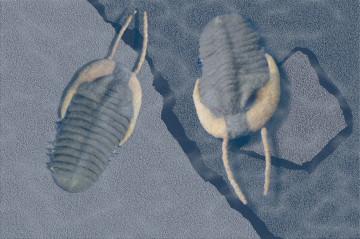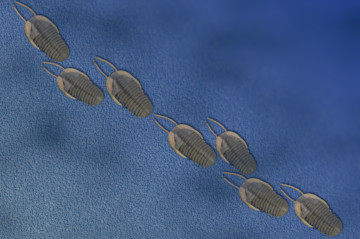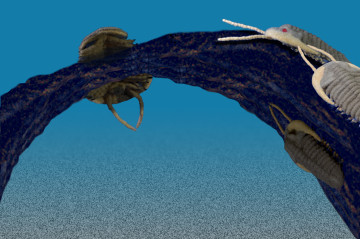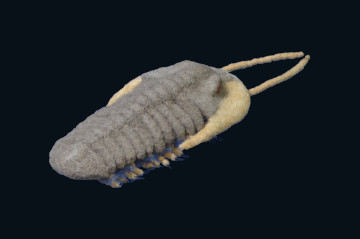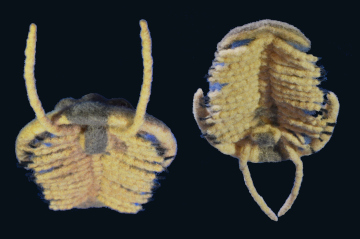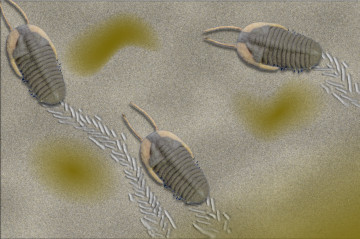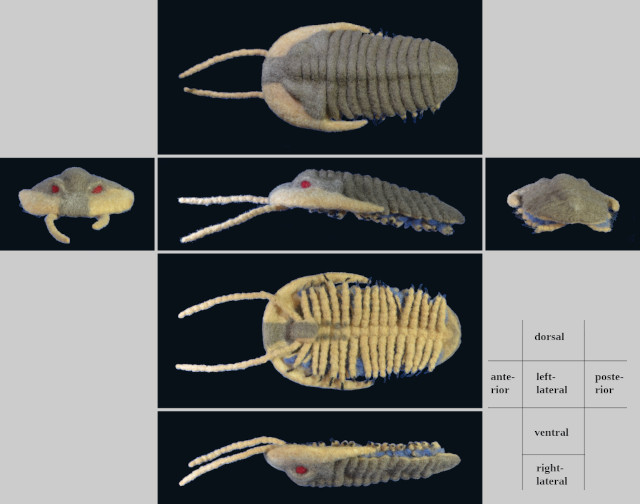Trilobite
Trilobite (Trilobita) is an extinct class of marine arthropods lived in the Paleozoic era, and is one of the index fossil of the Paleozoic 1), 2), 3).
The trilobites are a very large group, the class Trilobita, made up from 10 orders, over 150 families, 5,000 genera, and over 20,000 species 1).
They had appeared in the early Cambrian (about 520 million years ago), their flourished periods were the Cambrian and the Ordovician, subsequently, they had gradually declined until the Late Permian, and extincted with the Permian-Triassic extinction event (251 million years ago) 1).
Although the trilobites had been existing for nearly 300 million years (longer than dinosaurs), they had kept sharing similar body plan and had diversified maintaining the framework of their designs 2).
In contrast to the other Cambrian animals, the trilobites were already considered to belong to the arthropods until the end of the nineteenth century 3).
When the trilobites emerged about 521 million years ago, they already had equipied the advanced compound eyes and the features of arthropods, such as mineralized hard exoskeletons, jointed appendages, segmented body 2). But, their phylogenetic affinities in the arthropods are still controversial 3).
The dorsal skeleton of trilobites are longitudinally divided into three parts (leaf-like parts or lobes), that is, a central lobe and its both side lobes, which is origin of the name "trilobite" 1), 2), 3). But, we might focus on another "three parts", that is, a cephalon or armor-like head with spines extending backward, multiple segmented thorax or trunk, and a pygidium or flat tail part.
Most trilobites are about 2.5 cm in length, but its range is considerably wide, from under 1 cm to over 70 cm 1), 2).
A axial part of cephalon, which is called a glabella, is typically convex, and a pair of compound eyes are on the lateral sides of glabella. A pair of antennae extend forward from the ventral surface of head. A hypostome as a mouthpart also locates on the ventral of cephalon 3).
The thorax generally consists of between six and 15 segments. Each segment has a pair of biramous appendages beneath the pleura which is a dorsal exposkeleton extending laterally from axis portion. Outer branch of biramous has a gill structure, and inner branch is a walking leg 1), 3). The bases to which the both of inner and outer legs attach are a large and strong segments with spines are used to tear foods. Smashed foods are transported to the mouth opening at the posterior end of hypostome 1), 3).
The pygidium (tail part) constists of fused segments 1), 3).
Trilobites have been found from many different water environments, except fresh-water. Their feeding habitats are also diverse. Many trilobites are considered as benthic predators preying on smaller invertebrates, or scavengers of organic debris. Some species may have been detritivores or filter-feeders 1).
The trace fossils of trilobites have found from tidal flat deposits of the Lower Cambrian formation. There were desiccation cracks suggesting periodic drying 4). This means that some species of trilobites had been invading land of the Cambrian. Terrestrial animals may have evolved from marine rather than freshwater ancestors 4), and the trilobites may have been pioneers of animal landing on.
This needle felting work of trilobite has no specific model such as a family, or a genus, but, if I had to name one, it would be the Proetida. The Proetida had existed from the Ordovician to the Permian 1).
created in January 2017 - February 2017.
modified in June 2020.
modified in June 2020.
References:
- A Guide to the Orders of Trilobites
- American Museum of Naturla History Trilobite Website
- Australian Museum What are trilobites ?
- Mángano MG, Buatois LA, Astini R, Rindsberg AK (2014) Trilobites in early Cambrian tidal flats and the landward expansion of the Cambrian explosion. [abstract] Geology 42(2):143–146. (DOI:10.1130/G34980.1.)

